Artificial intelligence (AI) is the technology that enables machines to perform tasks that normally require human intelligence, such as learning, reasoning, and decision making. AI has many applications in various fields, including agriculture. Agriculture is one of the oldest and most important human activities, as it provides food, feed, fiber, and fuel for the world’s population.
However, agriculture also faces many challenges, such as climate change, population growth, water scarcity, pests, diseases, and environmental degradation. AI can help farmers and agribusinesses overcome these challenges and improve the productivity, profitability, and sustainability of agriculture. In this article, we will explore the role, advantages, and examples of AI in agriculture, and how it can revolutionize the food and agriculture sector in 2024 and beyond. 🌾
List of Best Artificial Intelligence Used In Agriculture
Role of Artificial Intelligence in Agriculture

AI can play a vital role in agriculture by enhancing the efficiency and effectiveness of various agricultural processes, such as:
Crop and soil monitoring: AI can help farmers monitor the health and growth of their crops, as well as the condition and quality of their soil, using sensors, drones, satellites, and computer vision. AI can also analyze the data collected by these devices and provide insights and recommendations for optimal crop management, such as irrigation, fertilization, pest control, and harvesting. 🚜
Smart agriculture :AI can help farmers automate and optimize their agricultural operations, such as planting, weeding, pruning, and picking, using robots, machines, and smart devices. AI can also help farmers control and coordinate their smart devices remotely, using cloud computing, internet of things (IoT), and mobile applications. 📱
Precision agriculture: AI can help farmers tailor their agricultural practices to the specific needs and characteristics of each crop, field, and plant, using big data, analytics, and machine learning. AI can also help farmers predict and adapt to the changing weather, climate, and market conditions, using forecasting, simulation, and optimization models. 🌦️
Artificial intelligence in plant disease detection: AI can help farmers detect and diagnose plant diseases, such as fungal, bacterial, viral, and insect infestations, using image recognition, natural language processing, and deep learning. AI can also help farmers prevent and treat plant diseases, using expert systems, chatbots, and smart sprayers. 🌱
Applications of AI in the field of Agriculture: AI can help farmers and agribusinesses improve their decision making, planning, and management, using data-driven and evidence-based tools, such as dashboards, reports, and alerts. AI can also help farmers and agribusinesses enhance their communication, collaboration, and education, using interactive and engaging platforms, such as social media, online forums, and e-learning. 📊
Advantages of Artificial Intelligence in Agriculture
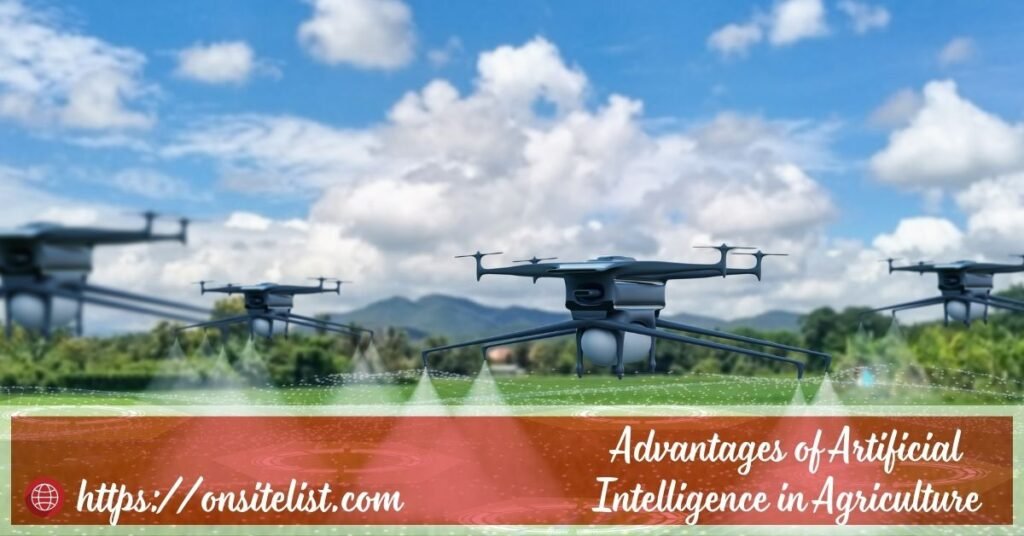
AI can offer many benefits for agriculture, such as:
Increasing crop yield and quality: AI can help farmers produce more and better crops, by optimizing the use of inputs, such as water, fertilizer, and pesticides, and by reducing the losses caused by pests, diseases, and weeds. AI can also help farmers improve the quality and safety of their crops, by ensuring the compliance with standards, regulations, and certifications. 🍅
Reducing costs and risks: AI can help farmers save money and time, by automating and streamlining their agricultural processes, and by providing them with accurate and timely information and guidance. AI can also help farmers mitigate the risks and uncertainties associated with agriculture, such as weather, climate, and market fluctuations, and by providing them with insurance, credit, and advisory services. 💰
Enhancing sustainability and resilience: AI can help farmers protect and conserve the natural resources and environment, by minimizing the negative impacts of agriculture, such as soil erosion, water pollution, and greenhouse gas emissions, and by promoting the adoption of sustainable and regenerative practices, such as organic farming, agroforestry, and permaculture. AI can also help farmers cope and recover from the effects of climate change, such as droughts, floods, and heat waves, and by enhancing their adaptive capacity and resilience. 🌳
This Related more Information Read: List Best Advantages and DisAdvantages In Agriculture AI In 2024
Crop and Soil Monitoring Using AI

One of the most important and challenging tasks for farmers is to monitor the health and growth of their crops, as well as the condition and quality of their soil. Traditionally, farmers rely on manual and visual inspection, which can be time-consuming, labor-intensive, and error-prone.
Moreover, manual and visual inspection can only cover a limited area and frequency, and can miss the subtle and early signs of problems. AI can help farmers overcome these limitations and improve their crop and soil monitoring, using the following technologies and methods:
Sensors: Sensors are devices that can measure and record various physical and chemical properties of the crops and soil, such as temperature, humidity, moisture, pH, salinity, nutrients, and organic matter. Sensors can be installed in the soil, on the plants, or on the farm equipment, and can transmit the data wirelessly to a central server or a mobile device. Sensors can provide farmers with real-time and continuous data on the status and performance of their crops and soil, and can alert them of any anomalies or issues. 🌡️
Drones: Drones are unmanned aerial vehicles that can fly over the fields and capture high-resolution images and videos of the crops and soil, using cameras, infrared, and multispectral sensors. Drones can cover large and inaccessible areas and can provide farmers with a bird’s eye view of their fields. Drones can also analyze the images and videos using computer vision and machine learning, and can provide farmers with insights and recommendations on crop management, such as irrigation, fertilization, pest control, and harvesting. 🛩️
Satellites: Satellites are spacecraft that orbit the earth and collect and transmit images and data of the earth’s surface, using optical, radar, and hyperspectral sensors. Satellites can cover vast and remote areas and can provide farmers with a global and historical perspective of their fields. Satellites can also analyze the images and data using computer vision and machine learning, and can provide farmers with insights and recommendations on crop management, such as crop identification, classification, and mapping, crop yield estimation and forecasting, and crop stress and damage assessment. 🛰️
Computer vision: Computer vision is the field of AI that enables machines to see and understand images and videos, using techniques such as image processing, feature extraction, object detection, segmentation, classification, and recognition. Computer vision can help farmers analyze the images and videos captured by the sensors, drones, and satellites, and can provide them with information and metrics on the crops and soil, such as crop type, variety, stage, density, height, biomass, chlorophyll, leaf area index, canopy cover, weed density, soil texture, color, and moisture. 👁️
Machine learning: Machine learning is the field of AI that enables machines to learn from data and experience, using techniques such as regression, classification, clustering, anomaly detection, and deep learning. Machine learning can help farmers interpret and integrate the data and information collected and generated by the sensors, drones, satellites, and computer vision, and can provide them with insights and recommendations on crop management, such as irrigation, fertilization, pest control, and harvesting. Machine learning can also help farmers predict and adapt to the changing weather, climate, and market conditions, using forecasting, simulation, and optimization models. 🧠
Related more information:
- Best Free Crop And Soil Monitoring Using AI For 2024
- List The Best Technologies Improving Agriculture Analytics in 2024
Smart Agriculture Using Artificial Intelligence

Another important and challenging task for farmers is to perform and optimize their agricultural operations, such as planting, weeding, pruning, and picking. Traditionally, farmers rely on manual and mechanical labor, which can be costly, scarce, and inconsistent.
Moreover, manual and mechanical labor can cause damage and waste to the crops and soil, and can expose the workers to health and safety hazards. AI can help farmers overcome these limitations and improve their agricultural operations, using the following technologies and methods:
Robots: Robots are machines that can perform physical tasks that normally require human or animal labor, such as planting, weeding, pruning, and picking. Robots can be autonomous or semi-autonomous, and can operate on the ground, in the air, or in the water. Robots can perform the tasks faster, more accurately, and more consistently than manual and mechanical labor, and can reduce the damage and waste to the crops and soil. Robots can also adapt to the varying and complex conditions of the fields, and can communicate and coordinate with each other and with the farmers. 🤖
Machines: Machines are devices that can assist or augment the human or animal labor, such as tractors, harvesters, sprayers, and plows. Machines can be equipped with sensors, cameras, and GPS, and can be controlled and monitored remotely, using cloud computing, internet of things (IoT), and mobile applications. Machines can automate and streamline the agricultural operations, and can provide the farmers with feedback and data on the performance and efficiency of the machines and the operations. 🚜
Smart devices: Smart devices are gadgets that can connect to the internet and other devices, and can provide the farmers with information and services, such as smartphones, tablets, smart watches, and smart glasses. Smart devices can help farmers access and visualize the data and information collected and generated by the sensors, drones, satellites, computer vision, and machine learning, and can provide them with insights and recommendations on crop management, such as irrigation, fertilization, pest control, and harvesting.
Precision Agriculture Using Artificial Intelligence
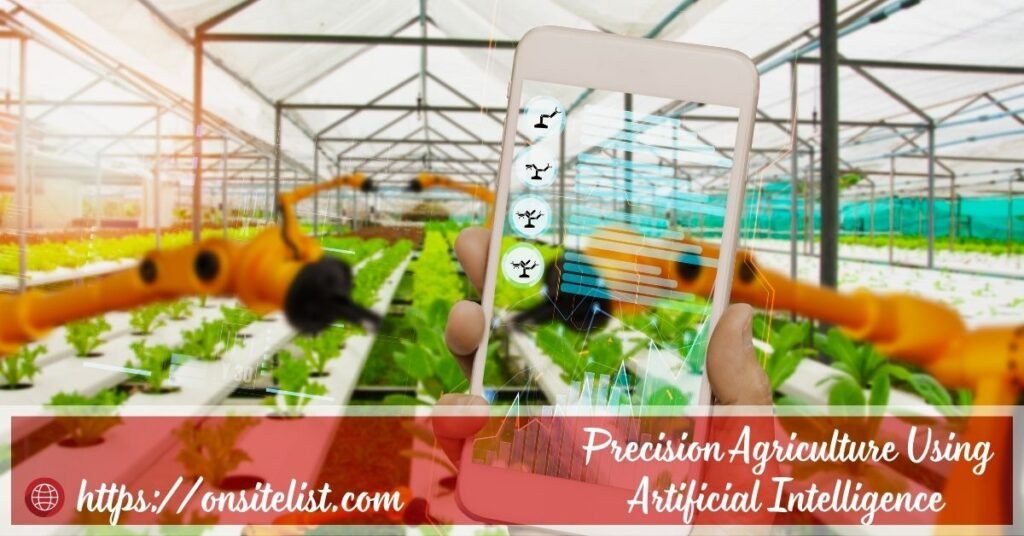
Precision agriculture is a farming approach that aims to optimize the agricultural practices to the specific needs and characteristics of each crop, field, and plant, using data, analytics, and technology.
Precision agriculture can help farmers increase their crop yield and quality, reduce their costs and risks, and enhance their sustainability and resilience, by enabling them to make more informed and accurate decisions. AI can help farmers implement and improve their precision agriculture, using the following technologies and methods:
Big data: Big data is the term that refers to the large and complex datasets that are generated and collected from various sources, such as sensors, drones, satellites, machines, smart devices, weather stations, and market platforms. Big data can provide farmers with a comprehensive and granular view of their fields and crops, and can reveal patterns, trends, and correlations that are otherwise hidden or unknown. 📈
Analytics: Analytics is the process of applying statistical and mathematical techniques to the big data, in order to extract and communicate meaningful and actionable insights. Analytics can help farmers understand and interpret the data and information collected and generated by the sensors, drones, satellites, computer vision, and machine learning, and can provide them with insights and recommendations on crop management, such as irrigation, fertilization, pest control, and harvesting. Analytics can also help farmers evaluate and compare the performance and outcomes of their agricultural practices, and identify the best practices and solutions. 📊
Machine learning: Machine learning is the field of AI that enables machines to learn from data and experience, using techniques such as regression, classification, clustering, anomaly detection, and deep learning. Machine learning can help farmers analyze and integrate the big data and analytics, and can provide them with insights and recommendations on crop management, such as irrigation, fertilization, pest control, and harvesting. Machine learning can also help farmers predict and adapt to the changing weather, climate, and market conditions, using forecasting, simulation, and optimization models. 🧠
Artificial Intelligence in Plant Disease Detection
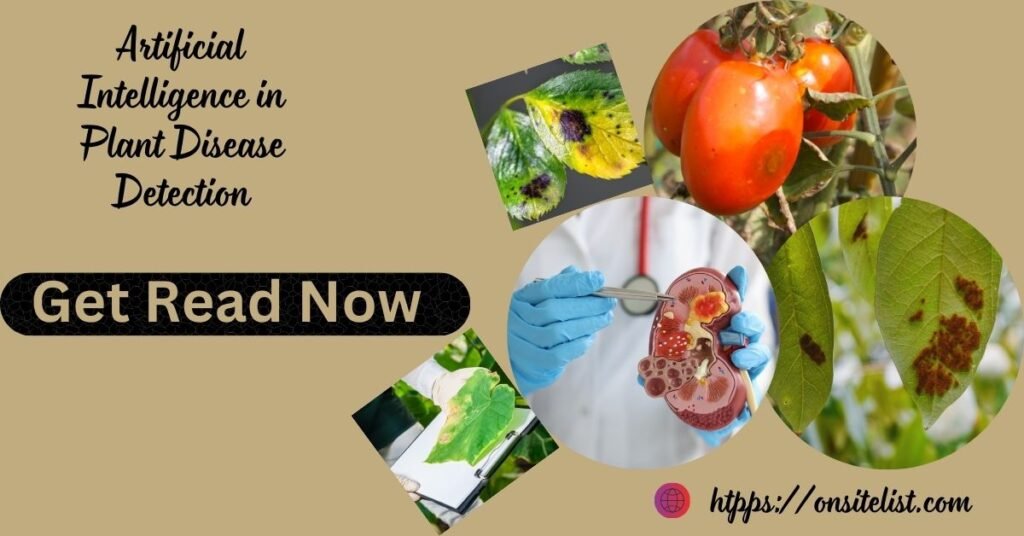
Plant diseases are one of the major threats to the health and productivity of crops, as they can cause significant losses in yield and quality, and can spread rapidly and widely. Plant diseases can be caused by various agents, such as fungi, bacteria, viruses, and insects, and can affect different parts of the plants, such as leaves, stems, roots, and fruits.
Plant diseases can be difficult to detect and diagnose, especially in the early stages, as they can have similar or subtle symptoms, and can vary depending on the crop type, variety, stage, and environment. AI can help farmers detect and diagnose plant diseases, using the following technologies and methods:
Image recognition: Image recognition is the field of AI that enables machines to identify and classify objects and scenes in images and videos, using techniques such as feature extraction, object detection, segmentation, classification, and recognition. Image recognition can help farmers detect and diagnose plant diseases, using cameras, infrared, and multispectral sensors, mounted on sensors, drones, satellites, robots, machines, or smart devices. Image recognition can analyze the images and videos captured by these devices, and can provide farmers with information and metrics on the plant diseases, such as disease type, severity, location, and extent. 👁️
Natural language processing: Natural language processing (NLP) is the field of AI that enables machines to understand and generate natural language, such as text and speech, using techniques such as tokenization, parsing, tagging, sentiment analysis, and natural language generation. NLP can help farmers detect and diagnose plant diseases, using text and speech inputs, such as descriptions, questions, and commands, provided by the farmers, experts, or other sources. NLP can also help farmers communicate and interact with the image recognition and machine learning systems, using chatbots, voice assistants, and smart speakers. 🗣️
Deep learning: Deep learning is a subfield of machine learning that uses artificial neural networks to learn from data and experience, using techniques such as convolutional neural networks, recurrent neural networks, and generative adversarial networks. Deep learning can help farmers detect and diagnose plant diseases, using image recognition and natural language processing, and can provide farmers with insights and recommendations on plant disease prevention and treatment, using expert systems, smart sprayers, and smart devices. Deep learning can also help farmers improve and refine their plant disease detection and diagnosis systems, using feedback, reinforcement learning, and transfer learning. 🧠
Applications of AI in the Field of Agriculture
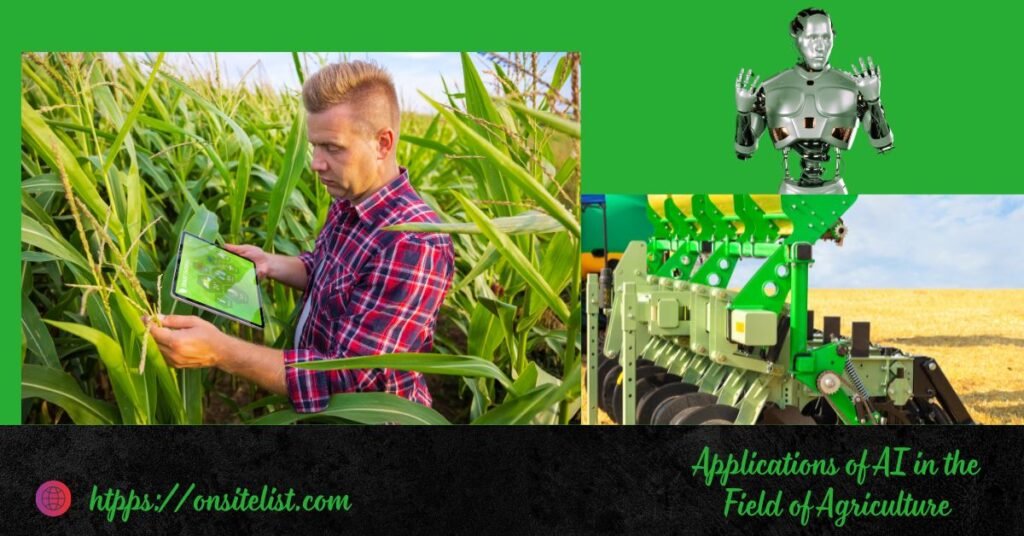
AI can help farmers and agribusinesses improve their decision making, planning, and management, using data-driven and evidence-based tools, such as dashboards, reports, and alerts. AI can also help farmers and agribusinesses enhance their communication, collaboration, and education, using interactive and engaging platforms, such as social media, online forums, and e-learning. Some of the applications of AI in the field of agriculture are:
Dashboards: Dashboards are graphical user interfaces that display and organize the data and information collected and generated by the sensors, drones, satellites, computer vision, machine learning, and analytics, and can provide farmers and agribusinesses with a comprehensive and intuitive overview of their fields and crops, and their performance and outcomes. Dashboards can also provide farmers and agribusinesses with insights and recommendations on crop management, such as irrigation, fertilization, pest control, and harvesting, and can alert them of any anomalies or issues. 📊
Reports: Reports are documents that summarize and communicate the data and information collected and generated by the sensors, drones, satellites, computer vision, machine learning, and analytics, and can provide farmers and agribusinesses with a detailed and structured analysis of their fields and crops, and their performance and outcomes. Reports can also provide farmers and agribusinesses with insights and recommendations on crop management, such as irrigation, fertilization, pest control, and harvesting, and can support them in their decision making, planning, and management. 📄
Alerts: Alerts are notifications that inform and warn the farmers and agribusinesses of any important or urgent events or situations that affect their fields and crops, such as weather, climate, and market changes, pest and disease outbreaks, and crop stress and damage. Alerts can also provide farmers and agribusinesses with insights and recommendations on how to respond and adapt to these events or situations, and can help them prevent or mitigate the negative impacts and risks. 🚨
Social media
Social media are online platforms that enable the farmers and agribusinesses to share and exchange the data and information collected and generated by the sensors, drones, satellites, computer vision, machine learning, and analytics, and to communicate and interact with each other and with other stakeholders, such as experts, customers, and suppliers.
Social media can also provide farmers and agribusinesses with feedback and reviews on their fields and crops, and their performance and outcomes, and can help them improve their reputation and brand. 📱
Online forums: Online forums are online communities that enable the farmers and agribusinesses to discuss and debate the data and information collected and generated by the sensors, drones, satellites, computer vision, machine learning, and analytics, and to seek and provide advice and support on crop management, such as irrigation, fertilization, pest control, and harvesting. Online forums can also provide farmers and agribusinesses with access and exposure to the latest trends and innovations in agriculture, and can help them learn from the best practices and experiences of others. 💬
E-learning: E-learning is the process of acquiring and enhancing the knowledge and skills related to agriculture, using online courses, modules, and materials, provided by the sensors, drones, satellites, computer vision, machine learning, and analytics, or by other sources, such as experts, institutions, and organizations. E-learning can also provide farmers and agribusinesses with assessment and certification on their knowledge and skills, and can help them improve their competence and confidence. 🎓
Artificial Intelligence to Improve the Food and Agriculture Sector
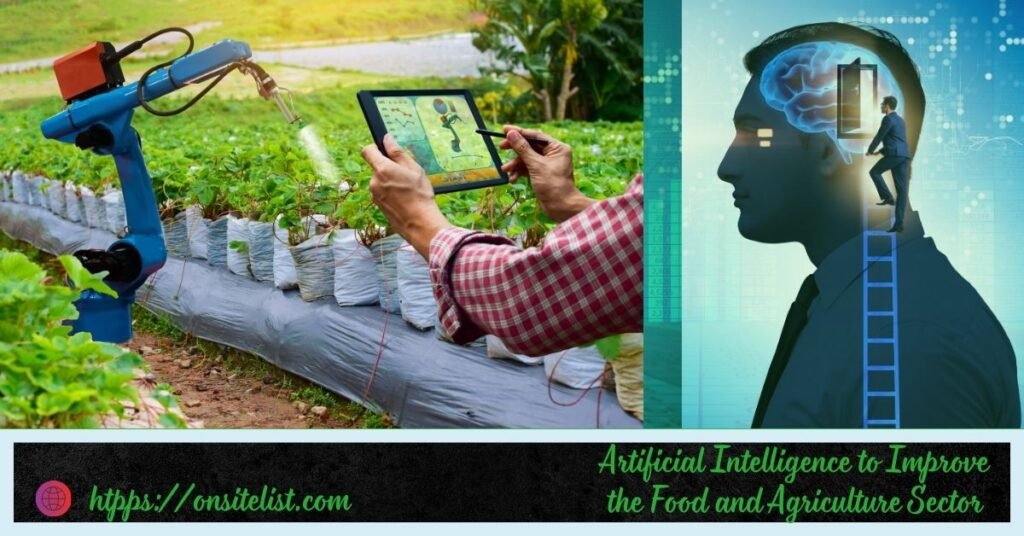
AI can help improve the food and agriculture sector, by addressing some of the key challenges and opportunities that the sector faces, such as:
Food security: Food security is the condition in which all people have physical and economic access to sufficient, safe, and nutritious food that meets their dietary needs and preferences for an active and healthy life. AI can help improve food security, by increasing the availability and affordability of food, by enhancing the quality and safety of food, and by reducing the losses and waste of food. 🍽️
Food safety: Food safety is the condition in which food is free from harmful agents, such as pathogens, toxins, and contaminants, that can cause illness or injury to humans or animals. AI can help improve food safety, by detecting and preventing the occurrence and spread of foodborne diseases, by ensuring the compliance with standards, regulations, and certifications, and by providing traceability and transparency of food products and processes. 🥘
Food quality: Food quality is the condition in which food meets the expectations and preferences of consumers and markets, in terms of taste, appearance, texture, freshness, nutrition, and sustainability. AI can help improve food quality, by enhancing the production and processing of food, by optimizing the storage and distribution of food, and by providing feedback and recommendations on food products and processes. 🍇
Food diversity: Food diversity is the condition in which food offers a variety and balance of different types, varieties, and sources of food, that contribute to the health and well-being of humans and animals, and to the conservation and enhancement of biodiversity and ecosystems. AI can help improve food diversity, by promoting the cultivation and consumption of diverse and nutritious crops, by supporting the development and innovation of new and alternative food products and processes, and by providing information and education on food
Impact of Artificial Intelligence on Agriculture

AI can have a significant impact on agriculture, by transforming the way farmers and agribusinesses produce, process, and distribute food, and by creating new opportunities and challenges for the sector. Some of the impacts of AI on agriculture are:
Economic impact: AI can have a positive economic impact on agriculture, by increasing the income and profitability of farmers and agribusinesses, by creating new markets and business models, and by enhancing the competitiveness and innovation of the sector. AI can also have a negative economic impact on agriculture, by disrupting the existing markets and business models, by increasing the costs and risks of adoption and implementation, and by creating inequalities and barriers to access and participation. 💵
Social impact: AI can have a positive social impact on agriculture, by improving the livelihoods and well-being of farmers and agribusinesses, by creating new jobs and skills, and by enhancing the education and empowerment of the sector. AI can also have a negative social impact on agriculture, by displacing or replacing the existing jobs and skills, by increasing the dependency and vulnerability of the sector, and by creating ethical and legal issues and dilemmas. 🙋
Environmental impact: AI can have a positive environmental impact on agriculture, by improving the efficiency and effectiveness of the use of natural resources and inputs, by reducing the emissions and waste of the sector, and by enhancing the conservation and restoration of biodiversity and ecosystems. AI can also have a negative environmental impact on agriculture, by increasing the consumption and demand of natural resources and inputs, by creating new sources and forms of emissions and waste, and by disrupting the balance and functioning of biodiversity and ecosystems. 🌎
Machine Learning Projects Based on Agriculture
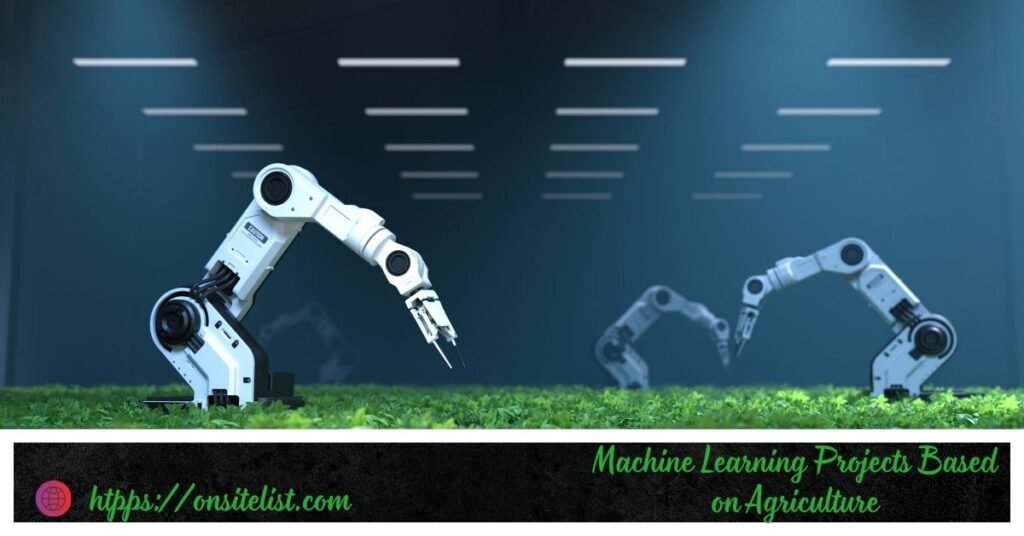
Machine learning is one of the most popular and powerful fields of AI, that enables machines to learn from data and experience, using techniques such as regression, classification, clustering, anomaly detection, and deep learning. Machine learning has many applications and projects based on agriculture, that can help farmers and agribusinesses solve various problems and achieve various goals. Some of the machine learning projects based on agriculture are:
Crop yield prediction: Crop yield prediction is the process of estimating the quantity and quality of crops that will be produced in a given area and time, using historical and current data on crop, soil, weather, climate, and management factors. Crop yield prediction can help farmers and agribusinesses plan and optimize their production and marketing strategies, and can help them mitigate the risks and uncertainties associated with agriculture. 🌽
Weed detection and classification: Weed detection and classification is the process of identifying and categorizing the unwanted plants that grow in the fields and compete with the crops for resources, using images and videos captured by sensors, drones, satellites, robots, machines, or smart devices. :Weed detection and classification can help farmers and agribusinesses control and eliminate the weeds, using manual, mechanical, or chemical methods, and can help them improve their crop yield and quality. 🌿
Fruit ripeness detection: Fruit ripeness detection is the process of determining the maturity and quality of fruits, using images and videos captured by sensors, drones, satellites, robots, machines, or smart devices. Fruit ripeness detection can help farmers and agribusinesses harvest and sort the fruits at the optimal time and condition, and can help them reduce the losses and waste of fruits. 🍎
Soil moisture estimation: Soil moisture estimation is the process of measuring and predicting the amount and distribution of water in the soil, using sensors, drones, satellites, or machine learning models. Soil moisture estimation can help farmers and agribusinesses irrigate and fertilize their crops more efficiently and effectively, and can help them conserve water and prevent soil erosion. 💧
Animal behavior analysis: Animal behavior analysis is the process of observing and understanding the actions and reactions of animals, such as livestock, poultry, and fish, using sensors, cameras, and machine learning models. Animal behavior analysis can help farmers and agribusinesses monitor and manage their animals more effectively and humanely, and can help them improve their animal health, welfare, and productivity. 🐮
Research Paper on Artificial Intelligence in Agriculture
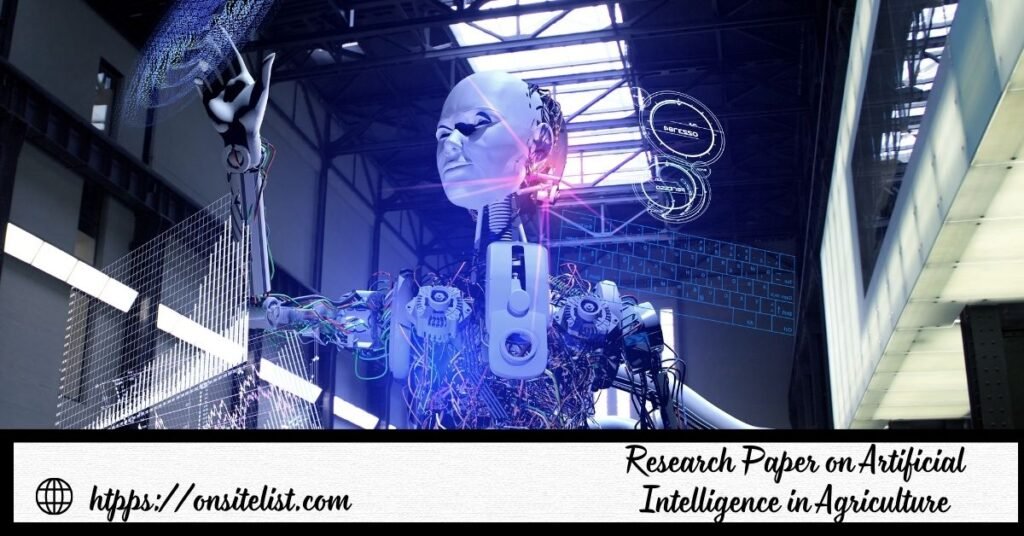
Artificial intelligence in agriculture is a hot and emerging topic of research, that attracts the interest and attention of many researchers and scholars from various disciplines and domains, such as computer science, engineering, agriculture, economics, and social sciences.
Artificial intelligence in agriculture is a multidisciplinary and interdisciplinary field of research, that explores the theory, methods, applications, and impacts of AI in agriculture, and that aims to advance the knowledge and practice of the sector. Some of the research papers on artificial intelligence in agriculture are:
A Review of Artificial Intelligence Methods in Agriculture: This paper provides a comprehensive and systematic review of the artificial intelligence methods used in agriculture, such as machine learning, computer vision, natural language processing, expert systems, and robotics. The paper also discusses the challenges and opportunities of AI in agriculture, and provides some future directions and recommendations for the field. 📝
Artificial Intelligence for Precision Agriculture: This paper presents a framework and a case study of artificial intelligence for precision agriculture, using big data, analytics, and machine learning. The paper demonstrates how AI can help farmers optimize their irrigation, fertilization, and pest control practices, using data from sensors, drones, satellites, and weather stations, and machine learning models. The paper also evaluates the performance and outcomes of the AI-based precision agriculture system, and provides some lessons learned and best practices. 📈
Deep Learning for Plant Disease Detection and Diagnosis: This paper proposes a novel and effective deep learning approach for plant disease detection and diagnosis, using convolutional neural networks and transfer learning.
The paper shows how the deep learning approach can achieve high accuracy and robustness in detecting and diagnosing various plant diseases, using images captured by smartphones, cameras, or drones. The paper also compares the deep learning approach with other existing methods, and provides some challenges and future work. 🌱
AI in Agriculture: A Case Study
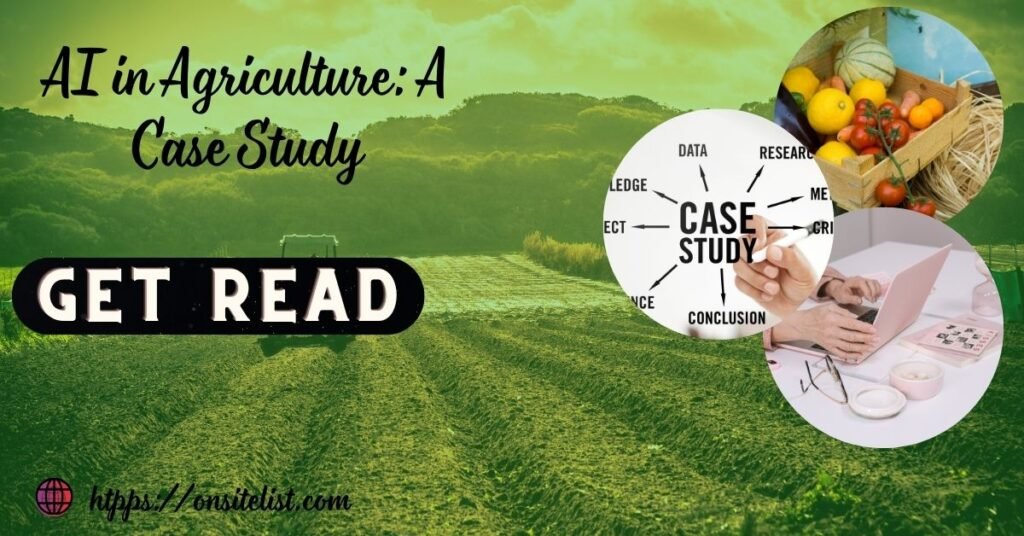
AI in agriculture is not only a topic of research, but also a reality of practice, that is being implemented and adopted by many farmers and agribusinesses around the world, with various degrees of success and impact. AI in agriculture is a context-specific and problem-oriented practice, that requires the integration and adaptation of various technologies and methods, according to the needs and characteristics of each situation and scenario.
AI in agriculture is also a collaborative and participatory practice, that involves the engagement and empowerment of various stakeholders, such as farmers, experts, customers, and suppliers. One of the examples of AI in agriculture is:
Farm Beats: Farm Beats is an AI-based platform that enables data-driven and precision farming, developed by Microsoft. Farm Beats uses low-cost sensors, drones, satellites, cloud computing, internet of things, and machine learning, to collect and analyze data on the crops and soil, and to provide farmers with insights and recommendations on crop management, such as irrigation, fertilization, pest control, and harvesting.
Farm Beats also uses TV white spaces, which are unused TV channels, to provide low-cost and high-speed internet connectivity to the farms. Farm Beats has been deployed and tested in various farms in the US, India, Africa, and Europe, and has shown positive results in improving the crop yield and quality, reducing the costs and risks, and enhancing the sustainability and resilience of the farms. 🌾
How can AI help in agriculture?
- Monitoring the crops and soil: AI can help farmers monitor the health and growth of their crops, as well as the condition and quality of their soil, using sensors, drones, satellites, and computer vision. AI can also analyze the data collected by these devices and provide insights and recommendations for optimal crop management, such as irrigation, fertilization, pest control, and harvesting. 🚜
- Automating and optimizing the agricultural operations: AI can help farmers automate and optimize their agricultural operations, such as planting, weeding, pruning, and picking, using robots, machines, and smart devices. AI can also help farmers control and coordinate their smart devices remotely, using cloud computing, internet of things, and mobile applications. 📱
- Tailoring the agricultural practices to the specific needs and characteristics of each crop, field, and plant: AI can help farmers tailor their agricultural practices to the specific needs and characteristics of each crop, field, and plant, using big data, analytics, and machine learning. AI can also help farmers predict and adapt to the changing weather, climate, and market conditions, using forecasting, simulation, and optimization models. 🌦️
- Detecting and diagnosing plant diseases: AI can help farmers detect and diagnose plant diseases, such as fungal, bacterial, viral, and insect infestations, using image recognition, natural language processing, and deep learning. AI can also help farmers prevent and treat plant diseases, using expert systems, chatbots, and smart sprayers. 🌱
- Improving the decision making, planning, and management: AI can help farmers and agribusinesses improve their decision making, planning, and management, using data-driven and evidence-based tools, such as dashboards, reports, and alerts. AI can also help farmers and agribusinesses enhance their communication, collaboration, and education, using interactive and engaging platforms, such as social media, online forums, and e-learning. 📊
- Increasing the crop yield and quality: AI can help farmers produce more and better crops, by optimizing the use of inputs, such as water, fertilizer, and pesticides, and by reducing the losses caused by pests, diseases, and weeds. AI can also help farmers improve the quality and safety of their
Conclusion
AI is a powerful and promising technology that can help farmers and agribusinesses improve the productivity, profitability, and sustainability of agriculture. AI can help farmers and agribusinesses monitor the crops and soil, automate and optimize the agricultural operations, tailor the agricultural practices to the specific needs and characteristics of each crop, field, and plant, detect and diagnose plant diseases, improve the decision making, planning, and management, and increase the crop yield and quality.
AI can also help farmers and agribusinesses reduce the costs and risks, enhance the sustainability and resilience, and improve the food security, safety, quality, and diversity of the sector. However, AI also poses some risks and challenges for agriculture, such as disrupting the existing markets and business models, creating inequalities and barriers to access and participation, and creating ethical and legal issues and dilemmas.
Therefore, it is important to adopt and implement AI in agriculture in a responsible and inclusive manner, that respects the values and interests of all the stakeholders, and that balances the benefits and risks of the technology. This can be achieved by developing and applying standards and guidelines, fostering and facilitating collaboration and participation, and providing and supporting education and training. AI can be a game-changer for agriculture, if used wisely and ethically. 🌾
The Onsite List gives you the best information about the Best AI Used In Agriculture in 2024. You can explore many other lists on onsitelist.com.